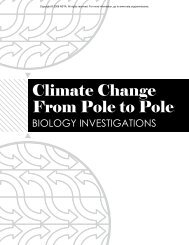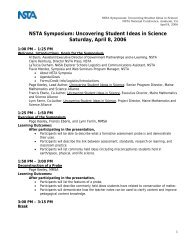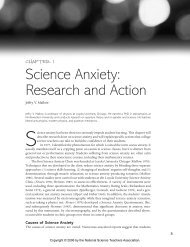Copyright © 2008 NSTA. All rights reserved. For more information ...
Copyright © 2008 NSTA. All rights reserved. For more information ...
Copyright © 2008 NSTA. All rights reserved. For more information ...
You also want an ePaper? Increase the reach of your titles
YUMPU automatically turns print PDFs into web optimized ePapers that Google loves.
xvi<br />
<strong>Copyright</strong> <strong>©</strong> <strong>2008</strong> <strong>NSTA</strong>. <strong>All</strong> <strong>rights</strong> <strong>reserved</strong>. <strong>For</strong> <strong>more</strong> <strong>information</strong>, go to www.nsta.org/permissions.<br />
Inquiring Minds Do Want to Know<br />
Figure 1.<br />
Breakdown of tornado lessons<br />
Day One: Informal Preassessment<br />
This was a chance for the students to get to<br />
know their new teachers, as well as an opportunity<br />
for the teachers to find out what<br />
the students knew about tornadoes.<br />
Day Two: Introduction to Tornadoes<br />
The lesson started witph the students returning<br />
from “specials” to find their classroom<br />
hit by a tornado. As the class put the<br />
desks and other classroom materials back<br />
in order there was a discussion on how a<br />
tornado can affect someone very personally.<br />
We then read two short accounts of<br />
tornado victims to enforce the idea of tornadoes<br />
being amazing forces of nature but<br />
also something that can affect someone’s<br />
life. We ended the class by introducing the<br />
idea of how tornadoes are formed by using<br />
bottle tornados as visual aids.<br />
Day Three: Panel of Experts<br />
We came into the classroom in costumes—we<br />
had a child who had lived through a tornado,<br />
a farmer, a tornado chaser, a weather forecaster,<br />
and a relief worker. We each gave the<br />
students a short talk on what we do when a<br />
tornado forms, and what kinds of things each<br />
expert finds really important. At the end of<br />
times the process is <strong>more</strong> important than the<br />
product . Wittrock and Barrow (2000) said that<br />
the teacher is <strong>more</strong> of a facilitator when teaching<br />
with inquiry, but, when I thought about that idea<br />
in a real-life scenario, it scared me to death . Still,<br />
I forged ahead and created a plan for the lesson<br />
by reviewing the research we had discussed in<br />
class and writing a rough time line . I tried to run<br />
through various scenarios and troubleshoot any<br />
roadblocks we might encounter .<br />
Two days later I presented the challenge to<br />
this lesson we gave them a worksheet to review<br />
the main points of the lesson and to keep<br />
in their science journals for future reference.<br />
Day Four: Science Safety<br />
The class had already discussed the basic<br />
ideas of how to be a safe scientist, so we decided<br />
to focus <strong>more</strong> on having each student<br />
sign a safety contract. Two of us dressed<br />
up as Science Safety Agents and explained<br />
what we expected from them as scientists.<br />
At the end of class we told the students that<br />
we wanted them to try to make a tornado<br />
next time we came and compiled a list of<br />
materials they requested.<br />
Day Five: Making a Tornado<br />
We brought in the materials, divided into<br />
groups, and let the students work through<br />
their ideas twice. The only assistance we gave<br />
them was when we handled the dry ice.<br />
Day Six: Assessment<br />
The class was divided into two groups. Different<br />
tornado and science safety facts that had<br />
been discussed throughout our classes were<br />
the basis of the review game questions. Each<br />
team worked together to formulate their answers<br />
and really knew their material.<br />
students in the classroom at our fifth visit. Students<br />
were primed for the challenge, because,<br />
at the conclusion of the fourth lesson, we had<br />
told students that we would be trying to create<br />
a tornado in the classroom on our next visit and<br />
we had brainstormed with them some materials<br />
we might need for this project: fans, spray bottles,<br />
bowls, and dry ice . Students chose fans to create<br />
wind and the spray bottles, because we had talked<br />
about humid air . They chose dry ice because it<br />
had been used recently in a school function, and<br />
NATIoNAL SCIENCE TEACHERS ASSoCIATIoN







